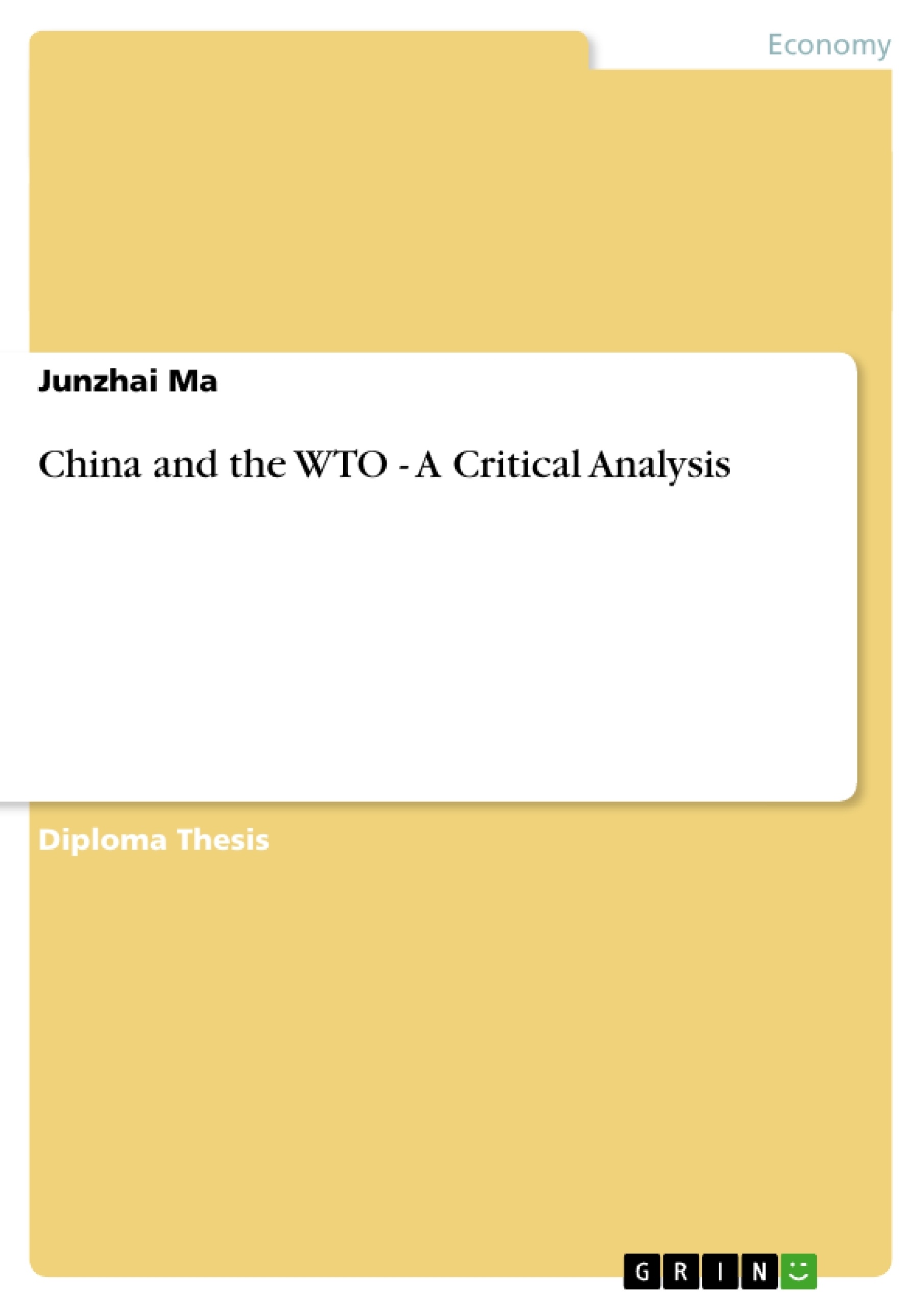This paper gives an analysis of China’s entry process into the WTO and an assessment on China’s accession commitment. The most important aspect of China’s performance and implementation is then analysed. The paper researches the impact that the WTO membership has brought to China and the world. The impact on rule of law is researched and the impact on trade growth as well as employment are analysed.
Inhaltsverzeichnis (Table of Contents)
- I. Introduction
- II. China's Entry into the WTO: A High, but Good Price?
- 1. Preparation Phase (1978-1986)
- 2. Negotiations to China's WTO Accession
- 2.1. Market Economy Status
- 2.2. Developing Country Status
- 3. Assessment of China's WTO Commitments
- 4. Summary
- III. Implementation and Participation: Has China been a Reliable Member?
- 1. General Points on Compliance and Participation
- 2. Special Aspects of China's WTO Participation and Implementation
- 2.1. China and TRIPS
- 2.2. China and Agreement on Textiles and Trade
- 2.3. China and Anti-Dumping
- 2.4. China and Technical Barriers to Trade
- 2.5. China and Regional Trade Agreements
- 3. Summary
- IV. The Impact of China's WTO Membership on China and the World
- 1. Impact on China
- 1.1. Impact on the Rule of Law
- 1.2. Impact on National Industries
- 1.2.1. The Automobile Industry
- 1.2.2. The Banking Sector
- 2. Impact on Developed Countries with the Example of the U.S.
- 3. Impact on Developing Countries with the Example of India
- 4. Summary
Zielsetzung und Themenschwerpunkte (Objectives and Key Themes)
This analysis critically examines China's entry into the World Trade Organization (WTO), evaluating the impact on China and the world at large. The author explores the negotiation process, China's adherence to WTO commitments, and the broader implications of its membership. The key themes of the analysis include:- The benefits and challenges of China's WTO accession
- The impact of China's WTO membership on its domestic economy and rule of law
- The influence of China's WTO membership on global trade patterns and the economies of developed and developing nations
- Specific areas of China's WTO participation, including intellectual property rights, textiles and trade, anti-dumping measures, and technical barriers to trade
- The role of regional trade agreements in shaping China's engagement with the global economy
Zusammenfassung der Kapitel (Chapter Summaries)
- Introduction: This chapter provides a brief overview of the research's scope and objectives. It sets the stage for the critical analysis of China's WTO membership, highlighting the significance of the topic and the research approach employed.
- China's Entry into the WTO: A High, but Good Price?: This chapter delves into the history of China's entry into the WTO, tracing the key stages from the initial preparations to the final negotiations. It examines the challenges and compromises faced by China during the accession process, specifically concerning its market economy status and developing country status. This chapter also critically assesses the commitments China made during the negotiation process, highlighting the potential costs and benefits of its WTO membership.
- Implementation and Participation: Has China been a Reliable Member?: This chapter explores the implementation and participation of China within the WTO. It evaluates China's compliance with its commitments and its overall engagement with the WTO's framework. The chapter focuses on specific aspects of China's WTO participation, including intellectual property rights, textiles and trade, anti-dumping measures, technical barriers to trade, and regional trade agreements. It examines China's adherence to these areas, considering both its successes and shortcomings.
- The Impact of China's WTO Membership on China and the World: This chapter investigates the impact of China's WTO membership on both its domestic economy and the global economy. It examines the influence of WTO membership on China's rule of law and its national industries, focusing on the automobile and banking sectors as illustrative examples. The chapter then delves into the impact of China's membership on both developed countries, using the United States as a case study, and developing countries, using India as an example. It analyzes the effects of China's WTO participation on trade patterns, economic growth, and other relevant factors.
Schlüsselwörter (Keywords)
This analysis focuses on key themes related to China's WTO membership, including its negotiations, implementation, and overall impact. It explores critical concepts such as market economy status, developing country status, intellectual property rights, trade agreements, regional trade agreements, anti-dumping measures, and the rule of law. Key examples include China's automobile and banking sectors, as well as case studies of the United States and India.
Final del extracto de 73 páginas
- subir
- Citar trabajo
- Junzhai Ma (Autor), 2007, China and the WTO - A Critical Analysis, Múnich, GRIN Verlag, https://www.grin.com/document/202683
Leer eBook



